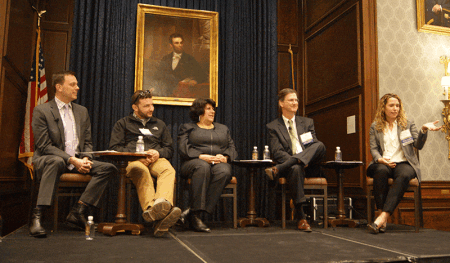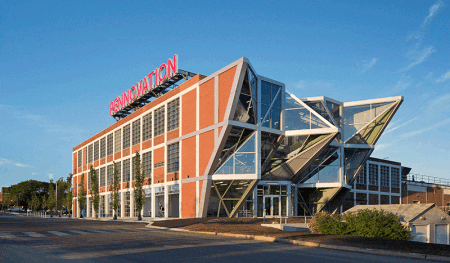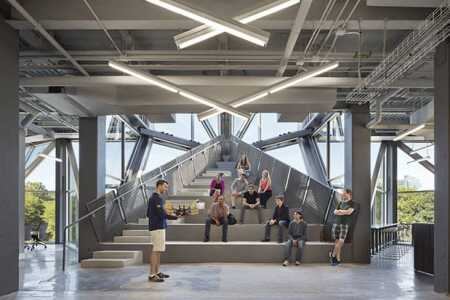How can land use foster the innovation economy? By partnering with anchor institutions and embracing the idea of a “minimum viable product,” where a stripped-down version is offered to early adopters and then modified based on the usage and other feedback, said development experts at a ULI Philadelphia event in February.
The sole reason that office buildings exist, said Stas Gayshan, managing director at the Cambridge Innovation Center, is to bring people together in physical proximity for the sake of collaboration. Especially given that today’s technology allows people to work from anywhere on almost any project, he said, there is no need to simply provide someone with a desk and workspace. Instead, every design decision in new office space should be made in service of the still-irreplicable experience of in-person collaboration. Anyone who creates an office with something else in mind is doing it wrong, Gayshan said.
If you think that sounds a little bit magical, think again, said Lindsey Scannapieco, founder and managing partner of Scout. In 2014, Scannapieco purchased the site of the former Bok Technical High School in south Philadelphia from the Philadelphia School District, with big plans to turn the city-block-sized fortress into a multipurpose mixed-use center for neighborhood artists and businesses. People doubted she could do it, she said, including her own father, condo developer Tom Scannapieco. But a few years later, she has 70 tenants, including a hairdresser, a daycare, a screen printer, a tattoo parlor, a photography collective, and architects’ studios. And more than that, the various tenants have found ways to collaborate and trade services, just by being in the same space together, she said.
The trick was to quickly demonstrate the “minimum viable product” for the building, a concept that Scannapieco said she borrowed from the tech industry. For Bok, that was the establishment of a rooftop bar, which brought thousands of people to the site within a few months of the opening. The bar concept on top of a closed public school was not without controversy, but it created some momentum around the building and showed that it could become a destination, Scannapieco said.

Panelists speaking at a recent ULI Philadelphia event, from left to right: Brian Selander, entrepreneur in residence at SeventySix Capital; Stas Gayshan, managing director of the Cambridge Innovation Center; Anne Papageorge, vice president of facilities and real estate services, University of Pennsylvania; Joe Reagan, senior vice president for development from Wexford Science + Technology; and Lindsey Scannapieco, managing partner, Scout. (SeventySix Capital)
Across town, at the site of another closed public school building, Wexford is trying to establish a similar sense of community, said Joseph Reagan, senior vice president of development for Wexford. In partnership with Drexel University, Wexford is planning a $1 billion transformation of the University City Sciences Center. The goal is to create a research space that is a counterpoint to the typical suburban office park, one that is urban, pedestrian-oriented, adaptable, and inspiring. The team, which also includes the Cambridge Innovation Center, is working to reestablish the street grid on what was once a superblock, allowing people to move through the site in ways that weren’t possible before. Recognizing that the university is the “long-term element” in the vicinity, Wexford is hoping to create a thriving “knowledge community” on the site.
The Pennovation Center near Penn’s campus is working to provide facilities for graduates and entrepreneurs to test out new research and business ideas, said Anne Papageorge, vice president for Facilities and Real Estate Services at the University of Pennsylvania. The university began looking at creating an innovation hub as it noticed funding for research flattening, in hopes of diversifying its operating budget, which is largely tuition and research grant dependent. In order to attract and retain young people who want to pursue innovative ideas, the Pennovation Center tries to offer short-term lease and license agreements. It also provides a base level fitout of space in the Center, which tenants can customize if they have the will and wherewithal.
“The idea, really, is to create a place that’s affordable, low-cost, and flexible and allows these young graduates to stay,” Papageorge said.
While the Pennovation Center is only a mile (1.6 km) from the middle of campus, Papageorge said that it’s not a particularly easy mile to travel, and the university is working with the city, the local business improvement district, and other partners to find ways to improve the trek. Better transportation infrastructure overall would lower the barriers to entry for startups considering locating in Philadelphia, she said. According to Gayshan, if Philadelphia wants to foster innovation, the city needs to think about its whole environment—from physical space to its own website—from the perspective of somebody who is trying to start something new. What information or access is needed? What gets in the way?
It comes down to recognizing the value of an ecosystem, the panel concluded, whether at the small level of an individual office or the macro-level of a whole city. The only reason Seattle is the city that it is today, said Brian Selander, an entrepreneur in residence at SeventySix Capital, in his opening remarks, is that Microsoft decided to locate there, and then Amazon followed suit, and so on. Ecosystems thrive when anchor institutions create opportunities for smaller ventures to try something new.






